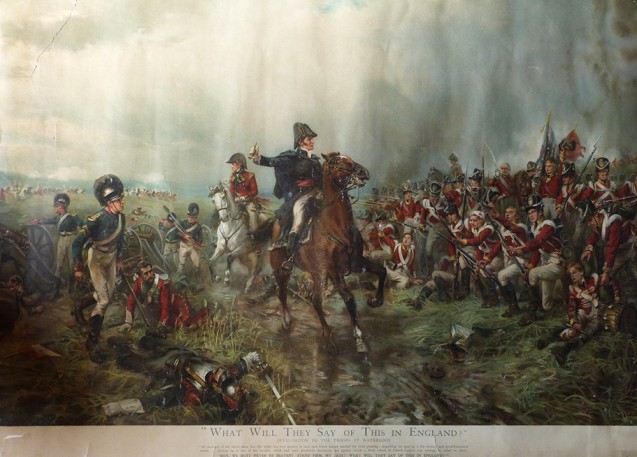The image presented here is a chromolithograph, in other words a colour lithograph (based on four colours – three primary colours and black – giving a full palette of tones) a printing method precursor to the offset printing process which largely replaced it from the 1930s onwards.
It’s a rather rare example of a colour lithograph of the Duke of Wellington. The colours are vibrant, and although at first sight, the work looks like a watercolour, so remarkable is the printing process, it is indeed a lithograph, even though certain colours have been added by hand after printing as well as varnish. Once produced in large numbers, the paper support was nevertheless fragile, easily torn and sometimes even rolled up, as this one seemed to have been. Now there are very few examples left.
Robert Alexander Hillingford was a relatively little-known genre painter of the second half of the 19th century. Despite the fact that the works by him listed in the early-twentieth-century encyclopedia of painters included no battle pictures, his series of oil paintings of the Battle of Waterloo were to be remarkably successful as lithographic prints – indeed, one such lithograph formed part of a Supplement to “Holly Leaves,” The Illustrated Sporting and Dramatic News Christmas Number, 1903, the year before Hillingford died.
The scene here shows Wellington galvanising his troops at Waterloo just before the arrival of a French attack. The quotation « What will they say of this in England? » (present as a caption below the lithography) probably comes from Sir Edward Shepherd Creasy’s The Fifteen Decisive Battles of the World: from Marathon to Waterloo, published in 1851: “All accounts of the battle show that the Duke was ever present at each spot where danger seemed the most pressing; inspiriting his men by a few homely and good-humoured words… Riding up to one of the squares, which had been dreadfully weakened, and against which a fresh attack of French cavalry was coming, he called to them: ‘Men, we must never be beaten! Stand firm my lads! What will they say of this in England?’“ Indeed, Creasy’s work was so famous that it was quoted in the Modern-Major-General’s famous patter song in Gilbert and Sullivan’s Pirates of Penzance: “quote the fights historical; from Marathon to Waterloo, in order categorical.”
Whilst he was to die soon after painting this work here, his later life was marked by numerous paintings depicting incidents before, during and after the battle of Waterloo. Other themes popular with the artist were the battles of the Duke of Marlborough, Dettingen, and military events of the seventeenth century. He even produced contemporary paintings such as Sebastopol; the attack on the Redan, exhibited in 1899, and his Royal Academy picture of 1901, “South Africa 1901: the dawn of Peace” in which Lord Kitchener on horseback holds up a peace proclamation surrounded by Boer Civilians. Hillingford paid close attention to accuracy in details of dress and had a collection of original uniforms. Indeed he was Vice President of the Kernoozers Club, the members of which were all collectors of objets d’art and militaria, but he achieved limited fame during his lifetime.
Peter Hicks, 13 February 2015


